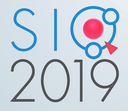Executive Secretary

VII Simposio Internacional de Química 2019
SIQ 2019
Most studies of signaling pathways analyze the levels of whole populations of modified/unmodified proteins in a group of cells. However, key signaling and cellular processes signal through different complexes and/or from various cellular compartments and differentially in individual cells. In addition, chronic diseases such as diabetic foot ulcers (DFUs) and hepatitis C virus (HCV) infection lead to cellular stress and extensive remodeling of intracellular membranes and organelles. To restore homeostasis under stress, cells adjust intracellular signaling and membrane contact sites (MCSs) allowing various processes such as organelle dynamics and autophagy. Heberprot-P (HPP) is an EGF-based therapeutic product (HeberBiotec S.A.,Havana, Cuba) that enhances healing of chronic wounds in patients with DFU. This study aimed to apply electron and immunoelectron microscopy (EM and IEM) approaches for ultrastructural study of cellular processes and to quantify distributions of relevant proteins across subcellular compartments under chronic diseases such as HCV and DFUs or after HPP therapy of DFUs. By using this methodology we have been able to link preferential subcellular localization and intracellular trafficking of key viral and host signaling molecules with remodeling of cellular membranes and processes. These effects were also associated with the therapeutic effect of HPP in DFUs. Notably, key MCSs like the mitochondria-associated endoplasmic reticulum membranes appeared as an important place for trafficking of these proteins and regulation of autophagy. Our approach revealed the value of quantifying subcellular localization of proteins at ultrastructural level to study intracellular dynamics of key signaling pathways in a relevant therapeutic setting.
Most studies of signaling pathways analyze the levels of whole populations of modified/unmodified proteins in a group of cells. However, key signaling and cellular processes signal through different complexes and/or from various cellular compartments and differentially in individual cells. In addition, chronic diseases such as diabetic foot ulcers (DFUs) and hepatitis C virus (HCV) infection lead to cellular stress and extensive remodeling of intracellular membranes and organelles. To restore homeostasis under stress, cells adjust intracellular signaling and membrane contact sites (MCSs) allowing various processes such as organelle dynamics and autophagy. Heberprot-P (HPP) is an EGF-based therapeutic product (HeberBiotec S.A.,Havana, Cuba) that enhances healing of chronic wounds in patients with DFU. This study aimed to apply electron and immunoelectron microscopy (EM and IEM) approaches for ultrastructural study of cellular processes and to quantify distributions of relevant proteins across subcellular compartments under chronic diseases such as HCV and DFUs or after HPP therapy of DFUs. By using this methodology we have been able to link preferential subcellular localization and intracellular trafficking of key viral and host signaling molecules with remodeling of cellular membranes and processes. These effects were also associated with the therapeutic effect of HPP in DFUs. Notably, key MCSs like the mitochondria-associated endoplasmic reticulum membranes appeared as an important place for trafficking of these proteins and regulation of autophagy. Our approach revealed the value of quantifying subcellular localization of proteins at ultrastructural level to study intracellular dynamics of key signaling pathways in a relevant therapeutic setting.
Sobre el ponente

Dr. Nelson Acosta Rivero






